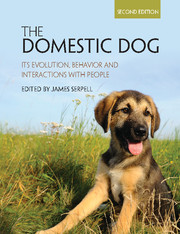Book contents
- Frontmatter
- Dedication
- Contents
- List of contributors
- 1 Introduction
- PART I ORIGINS AND EVOLUTION
- PART II BEHAVIOR, COGNITION AND TRAINING
- PART III DOG-HUMAN INTERACTIONS
- 13 Dogs as helping partners and companions for humans
- 14 The welfare of dogs in human care
- 15 From paragon to pariah: Cross-cultural perspectives on attitudes to dogs
- PART IV LIFE ON THE MARGINS
- Index
- Plate section
- References
14 - The welfare of dogs in human care
from PART III - DOG-HUMAN INTERACTIONS
Published online by Cambridge University Press: 30 December 2016
- Frontmatter
- Dedication
- Contents
- List of contributors
- 1 Introduction
- PART I ORIGINS AND EVOLUTION
- PART II BEHAVIOR, COGNITION AND TRAINING
- PART III DOG-HUMAN INTERACTIONS
- 13 Dogs as helping partners and companions for humans
- 14 The welfare of dogs in human care
- 15 From paragon to pariah: Cross-cultural perspectives on attitudes to dogs
- PART IV LIFE ON THE MARGINS
- Index
- Plate section
- References
Summary
Introduction
The majority of domestic dogs in Western countries are companion or pet animals. However, dogs are also used as working and laboratory animals, and may live alongside human society in feral or free-roaming populations. In each of these different types of relationship, situations arise in which dog welfare may be compromised. Most people would agree that we have a duty of stewardship to the dogs that we own, and that we have some responsibility for the welfare of dogs that become ownerless, or which have suffered or are likely to suffer harm as a result of human actions. For all these dogs we need to make decisions on their care, housing, methods of transport, medical care, euthanasia, and other issues, and these decisions should be based on the best available evidence.
This chapter provides a brief introduction to the subject of welfare and its assessment. It focuses on some of the welfare issues that affect dogs (genetic welfare problems, issues relating to dogs as companions and their housing and care), discusses their causes, and indicates how some of these problems might be alleviated.
What do we mean by welfare?
Welfare scientists have not always agreed as to how welfare should be defined (Fraser et al., 1997). Our view is that what matters to the animal, and hence what should matter most to us, is that it is healthy and generally feeling a range of positive and pleasurable feelings rather than negative experiences such as pain, boredom, frustration, and so on (Dawkins, 1980, 2004; Duncan, 1993; Kirkwood, 2006).
How good can it get?
Many of the traditional concerns about animal welfare have been about correcting states of poor welfare resulting, for example, from poor husbandry or cruelty. However, those who care for dogs often want to do more, wishing to provide a “good life” full of positive experiences and good feelings. Some animal welfare scientists and regulatory agencies are beginning to give thought to ideas such as “quality of life” and “a life worth living” (e.g. Farm Animal Welfare Council, 2009; Grandin & Johnson, 2009, p. 5; Taylor & Mills, 2007; Yeates, 2011; Yeates & Main, 2009). These concepts are not, however, simple.
- Type
- Chapter
- Information
- The Domestic DogIts Evolution, Behavior and Interactions with People, pp. 271 - 299Publisher: Cambridge University PressPrint publication year: 2016
References
- 3
- Cited by



